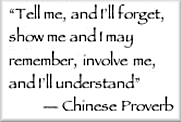-
Anchored learning
普通类 -
- 支持
- 批判
- 提问
- 解释
- 补充
- 删除
-
-
introduction
IN AN ANCHORED LEARNING environment, the activities are designed around a realistic situation -- or anchor -- in which there is a problem to be solved by the group. Originally developed by the Cognition and Technology Group at Vanderbilt, this method encourages students to view knowledge as tools to be applied to new situations, rather than knowledge as facts to be learned. Curriculum materials are often technology based, and provide a positive effect on student achievement, including for students with special needs.
在抛锚式学习环境里,活动是围绕着现实环境而设计的.。这种环境或者锚,在其中,有一个需要群体解决的问题。原来是由在万德贝尔特的认知和技术团队开发的。这种方法鼓励学生把知识看成是工具应用到新的情境,而不仅仅将知识看成已学习过的事实而已。课程材料经常是基于技术的,给学习成绩提供积极的影响,包括满足学生特别的需要。
-
How does it work?
.gif)
Anchored instruction requires putting the students in the context of a problem-based story. The students "play" an authentic role while investigating the problem and the developing situations. In this framework, the student is given the tools needed to solve the problem.
抛锚式教学要求把学生置于基于问题的情境中。在对问题和解决问题的情境展开调查时,学生“扮演着”一个真实的角色。在这种机制下,要给学生提供解决问题所需要的工具。
-
Research

Research shows that ordinary classroom learning is very different from "natural" learning environments. Natural learning environments, like those in which parents help their child develop a language, are often characterized as "contextualized." The parent and child share a context, or a common frame of reference, in which learning takes place. Teachers in traditional learning environments often do not share a common context for instruction, and therefore students fail to see the knowledge they learn in school as a tool to solve problems in the "real world". Anchored Instruction is designed to bridge the gap between natural and school learning environments.
研究表明传统课堂学习与“自然的”学习环境有很大不同。自然学习环境,与那些父母帮助他们的子女学习一门语言的环境一样,它们通常的特点是“情境化”。父母和子女共享一个情境,或者叫一个共同的参照系,在这个情境里学习发生了。传统课堂里的教师在教学时通常没有给学生分享一个共同的情境,因此,学生不能把他们在学校学到的知识看做“现实世界”里解决问题的工具。设计抛锚式教学的目的是为了在自然学习环境与学校学习环境之间架起一座桥梁从而弥补它们之间的差距。
-
Traditional learning vs. anchored learning:
Traditional:Lecture based Student is a passive listener Facts are learned ;
Anchored:Technology based Student is active and involved Problems are solved ;传统学习 VS 抛锚式学习
传统学习:基于讲座的;学生作为被动的学习者;学生学到了事实(知识)
抛锚式学习:基于技术的;学生是主动的、与他人密切联系的;学生解决了问题
-
Creating your own Anchored Learning environment:(创设你自己的抛锚式教学环境)
All data required to solve the problem should be embedded in the story line. The presentation should be as realistic as possible. Keep in mind that the ability to refer back to segments is a useful design consideration. Regular videotape would be inadequate for quick playback, while most multimedia formats can be replayed easily with the click of a button.
An anchored module can be provided as a high production value multimedia presentation or as a simple web page. On the web pages, audio, video, and graphics can help to promote realism. More complex anchored learning situations include a story that would change in accordance with the students inputs, giving them "control" over their end results.
构建属于你自己的抛锚式学习环境
应该把解决问题所需要的所有数据都嵌入”情景线“里。这些数据的呈现要尽可能的真实。切记能够回头查阅已有情景片段的设计考虑是非常有效的。常规的录像带对于快速回放的操作是不能胜任的,然而大多数多媒体设备只需要按下一个按钮就能轻松实现重放功能。
一个抛锚式的模块可以是高产值的多媒体演示也可以是一个简单的网页。网页上的音频、视频和图片能够提高真实性。更复杂一点的抛锚式学习情境包括这样一个情景,这个情景能够随着学生的输入的改变而改变从而与其始终保持一致,并且能够对最终的输出结果给予”控制“。
-
author
Taryn Floodman, Educational Technologist
Floodman, T. (2004). Anchored learning. In B. Hoffman (Ed.), Encyclopedia of Educational Technology. Retrieved July 14, 2010, -
-
- 标签:
- 学习
- 学生
- 情境
- 抛锚式
- 情景
- anchored
- students
- learning
- 能够
- 学习环境
-
加入的知识群:



学习元评论 (0条)
聪明如你,不妨在这 发表你的看法与心得 ~